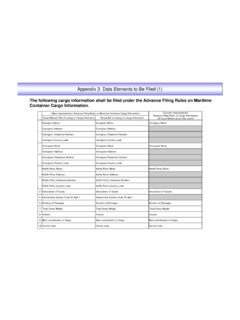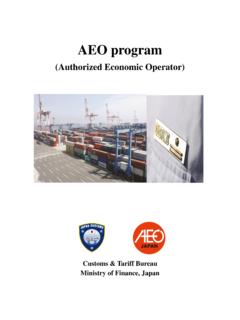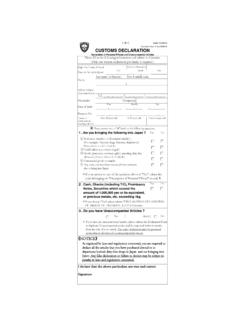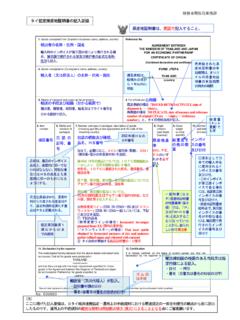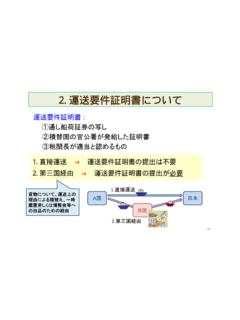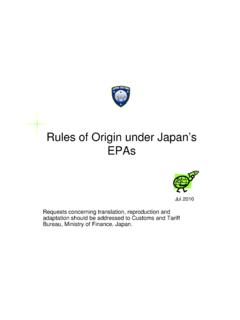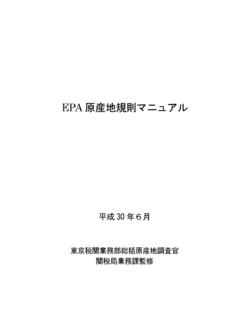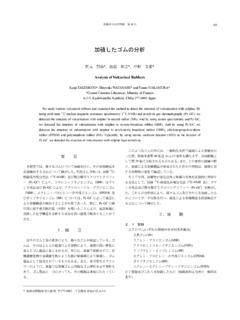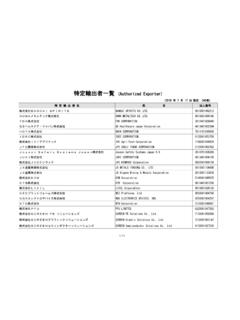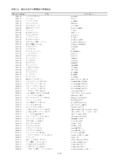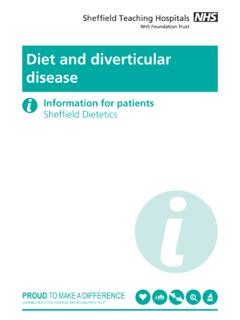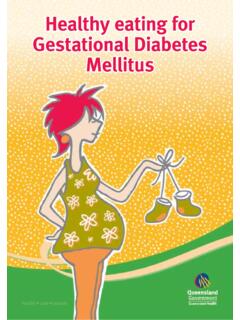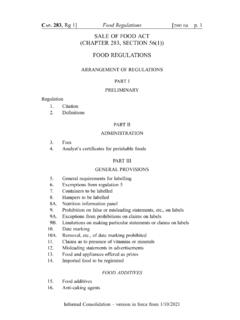Transcription of OUTLINE OF RULES OF ORIGIN - Customs
1 OUTLINE OF RULES OF ORIGINCUSTOMS AND TARIFF BUREAUMINISTRY OF FINANCEJAPANJ U RULES OF ORIGIN ?.. CRITERIA OF EPA .. CRITERIA OF GSP .. RULES OF ORIGIN .. About this brochure -This brochure aims to introduce the basic concepts of RULES of ORIGIN (ROO). For ease of understanding, some words and expressions used in this brochure may be different from what is provided for in the legal texts ( Economic Partnership Agreements). For questions, please contact the ROO divisions of Japan Customs listed at the end of the brochure. July 2017 Customs and Tariff Bureau, Ministry of FinanceWHAT ARE RULES OF ORIGIN ?1 RULES of ORIGIN (ROO) are the RULES to determine the country of ORIGIN of goods. Since the application of a certain Customs and tariff policy ( applicable tariff rates) depends on the ORIGIN of goods, ROO is necessary so that the ORIGIN of goods is determined in an objective do we need RULES of ORIGIN ?
2 If only one country is involved in the production of a good, it is fairly straightforward to determine the country of ORIGIN (see Case 1). On the other hand, if more than one country is involved in the production (see Case 2), there must be a rule to determine which country is the ORIGIN of the good. RULES of ORIGIN also play a role in ensuring that the preferential tariff rates are applied only to the originating goods of the eligible countries ( anti-circumvention).Types of RULES of originRules of ORIGIN are categorized into preferential RULES of ORIGIN and non-preferential RULES of ORIGIN . Preferential RULES of ORIGIN include the RULES for the application of the preferential tariff rates under Economic Partnership Agreements (EPA) and the RULES for the application of the preferential tariff rates under the Generalized System of Preferences (GSP). Non-preferential RULES of ORIGIN are applied to determine the country of ORIGIN for the purposes other than granting of preferential tariff treatment (such as the application of WTO tariff rates, trade statistics, etc.)
3 RULES of ORIGIN and ORIGIN proceduresRules of ORIGIN generally consists of ORIGIN criteria and ORIGIN procedures. ORIGIN criteria stipulate conditions or requirement for a goodto be considered as originating . ORIGIN procedures provide for the course of action to be followed when applying the preferential tariff rates. Preferential RULES of ORIGIN Non-preferential RULES of ORIGIN (application of WTO tariff rates, trade statistics, etc.)(1) application of EPA (Economic Partnership Agreement) tariff rates(2) application of GSP(Generalized System of Preferences) tariff ratesCase 1 Case 2 Beef produced from cattle born and raised in AustraliaWine fermented in Chile from grapes harvested in Chile, and bottled in Australia AustraliaChileAustralia* ORIGIN criteria include not only the definition of originating goods but also other provisions such as accumulation (considering originating goods of a party as that of another party) and de minimis (allowing the use of non-originating material(s) up to a certain limit).
4 Please note that this brochure focuses on the general definition of originating goods and does not cover details of various provisions. For further details, please refer to the information regarding the respective RULES of : AustraliaOrigin: Chile? ORIGIN : Australia?1 ORIGIN CRITERIA OF EPA As of April 2017, Japan is a party to 15 Economic Partnership Agreements (EPA). Under the Customs Act of Japan, the provisions on RULES of ORIGIN in each agreement are directly applied. In general, originating goods are either: wholly obtained goods , goods produced exclusively from originating materials , or goods satisfying the product-specific RULES (PSR) . Please note that the RULES of ORIGIN of each EPA reflect the result of negotiations with the partner countries, thus there are slight differences from one agreement to another. Wholly obtained goodsWholly obtained goods are the goods whose production is completed in one satisfying the product-specific RULES (PSR)Even if the materials from third countries (non-originating materials) are used in the production, goods are considered as originating when the goods satisfy the requirement set out in the product-specific RULES (PSR).
5 PSR is generally provided as an annex to each most of the EPAs that Japan is a party to, PSR is stipulated in the form of either: change in tariff classification , qualifying/regional value content , specific manufacturing or processing , or a combination of produced exclusively from originating materialsGoods produced exclusively from originating materials are the goods produced using originating materials only. Because all the materials used in the production are originating materials, the production is seemingly completed in one country. However, there is the case where materials from a third country ( non-originating materials) are used in the production of the originating : Live animal born and raised in the territory of a country (livestock)Example: Minerals and other natural resources extracted or taken in the territory of a country (crude oil)Contracting partyOliveOlive oilOlive soapThird countryJapan2 Originating material(2) Qualifying Value Content (QVC)/Regional Value Content (RVC)Goods are considered as originating if a certain value (%) is added through the production undertaken in the territory of a party/country, and the value added exceeds the prescribed threshold (%).
6 (1) Change in tariff classificationGoods are considered as originating if there is a certain change between the tariff classification of the non-originating materials and the tariff classification of the (final) goods.(3) Specific manufacturing or processingGoods are considered as originating if the goods undergo a specific manufacturing or processing such as chemical reaction, distillation, purification, etc. in the territory of a party/country.* Tariff classification is based on the Harmonized System (the Harmonized Commodity Description and Coding System). Under the Harmonized System (HS), classification numbers are allocated to each commodity/item in Chapter (2 digit), Heading (4 digit), and Subheading (6 digit).JapanAustraliaValue of non-originating materials (CIF)Labor costValue of originating materialsManufacturing costProfitOtherTotal value of the good (FOB)Value addedChinaUSD 2,000(Example) PSR for a passenger vehicle of heading under Japan-Australia EPA: the value added in the country of manufacture (Qualifying Value Content) is not less than 40% and the last process of production has been performed in the exporting partyJapanMalaysiaAustraliaGlycerol(Exam ple) PSR for glycerol of subheading under Japan-Australia EPA: the goodhas undergone a chemical reaction in the area of a party.
7 Chemical reaction is defined as a process which results in a molecule with a new beans(Example) PSR for soya sauce of subheading under Japan-Thailand EPA: change of heading (change in the first 4 digits of the HS: Harmonized Commodity Description and Coding System)* soya sauceHeading ReactionUSD 10,000 Value of good (USD 10,000) Value of non-originating materials (USD 2,000)Value of good (USD 10,000)80% ( > 40% QVC)=3 ORIGIN CRITERIA OF GSP Under the Generalized System of Preferences (GSP), Japan grants preferential tariff treatment (lower tariff rates) to the originating goods of the eligible developing countries. The RULES of ORIGIN of GSP are stipulated in the Cabinet Order and Finance Ministry Ordinance for the Enforcement of the Act on Temporary Measures concerning goods under GSP are either: wholly obtained goods or goods that have undergone substantial transformation .Wholly obtained goodsGoods are considered as originating goods of a beneficiary country if the goods are wholly obtained or produced in a single beneficiary country.
8 The concept is almost the same as the wholly obtained goods under EPAs. Its definition is provided for in Article 8 of the Ordinance for the Enforcement of the Act on Temporary Measures concerning that have undergone substantial transformationEven if the goods are produced using materials from other countries, goods are considered as originating goods of a beneficiary country if the goods are produced through a manufacturing or processing which satisfies the requirement to be considered as substantial transformation . In general, substantial transformation requires such production that leads to a change of heading (HS 4 digit) between the tariff classification of the non-originating materials and the good produced. It is provided for in Article 8 of the Ordinance for the Enforcement of the Act on Temporary Measures concerning for the goods listed in the Appendix to the Ordinance for the Enforcement of the Act on Temporary Measures concerning Customs , a good needs to satisfy the requirements provided in the Appendix to be considered as originating.
9 (Example) Tableware of heading (Example) rule listed in the Appendix for a tie of heading : manufacture from yarnHowever, even if the above criteria are satisfied, goods are NOT considered as originating if the last processing operation is either: to ensure the preservation of the product in good condition during transport and storage, simple cutting, repacking, affixing of marks, fabricTie Beneficiary countryKaolinTableware of porcelainHeading countryNON-PREFERENTIAL RULES OF ORIGIN As for non-preferential RULES of ORIGIN , each country has its own RULES in accordance with the WTO Agreement on RULES of Japan, non-preferential RULES of ORIGIN are provided for in the Cabinet Order for the Enforcement of the Customs Act, etc. Under these regulations, in general, the country of ORIGIN of the imported goods is determined by the following: Goods wholly obtained in a single country or area as defined in Finance Ministry Ordinance for the Enforcement of the Customs Act.
10 Goods produced using materials not wholly obtained in the country of production, while having undergone a manufacturing or processing operation which qualifies as substantial transformation defined in Finance Ministry Ordinance for the Enforcement of the Customs obtained goodsThe definition of wholly obtained goods is basically the same as that of EPA and GSP. It is provided for in the Finance Ministry Ordinance for the Enforcement of the Customs that have undergone substantial transformationSubstantial transformation is defined as such manufacturing or processing that leads to change of heading (HS 4 digit) between the tariff classification of the non-originating materials and the classification of the good produced. However, operation to ensure the preservation of the products in good condition during transport and storage, simple cutting, repacking, affixing of marks, etc. are NOT considered as substantial transformation even if change of heading RULES of ORIGIN : scope of applicationThe following are the scope of application of the non-preferential RULES of ORIGIN and the legal tariff rateArticle ofthe Order for the Enforcement of the CustomsActTrade Remedies (suchas Anti-dumping duty)Cabinet Order concerning the Application of Anti-dumping Duty on aspecific product (determined in accordance with Article ofthe Order for the Enforcement of the CustomsAct), markingArticle 71 of Customs ActTrade statisticsJapan Customs Notice onthe Statistics concerning Foreign Trade 7-2 (determined in accordance with Article ofthe Order for the Enforcement of the CustomsAct)5 ORIGIN PROCEDURES ORIGIN procedures are the course of action to be followed when applying the preferential tariff rates.
